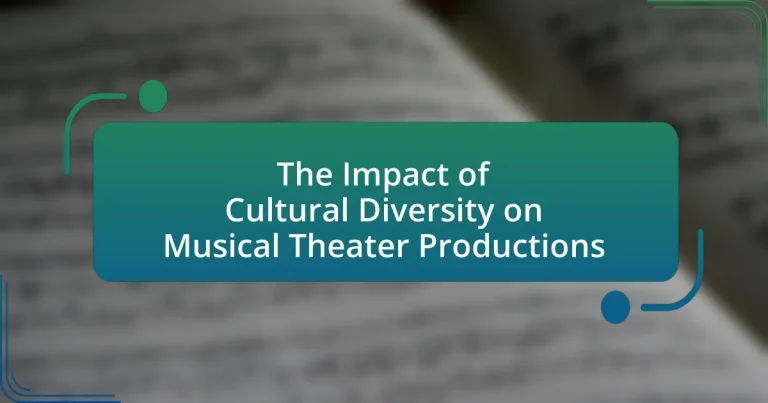The article examines the impact of cultural diversity on musical theater productions, highlighting how it enhances storytelling, character development, and audience engagement. It discusses the influence of diverse themes such as identity, migration, and community, and provides examples of successful productions like “Hamilton” and “In the Heights.” The article also addresses the significance of diverse casting and creative teams in promoting authentic representation, as well as the challenges faced in incorporating cultural diversity. Additionally, it outlines best practices for producers to ensure inclusivity and support for diverse talent in the theater industry.

What is the impact of cultural diversity on musical theater productions?
Cultural diversity significantly enhances musical theater productions by introducing varied perspectives, narratives, and artistic expressions. This inclusion fosters richer storytelling and character development, allowing for a more authentic representation of diverse communities. For instance, productions like “Hamilton” have successfully integrated diverse casting and cultural elements, leading to critical acclaim and broader audience engagement. Research indicates that diverse casts can increase ticket sales and audience demographics, as seen in the success of shows that embrace multicultural themes and talent.
How does cultural diversity influence the themes in musical theater?
Cultural diversity significantly influences the themes in musical theater by introducing a variety of perspectives, narratives, and cultural expressions. This diversity allows for the exploration of complex social issues such as identity, race, and belonging, which are often reflected in the stories told on stage. For instance, productions like “West Side Story” and “The Lion King” incorporate elements from different cultures, showcasing the richness of those traditions while addressing themes of conflict and unity. Additionally, the inclusion of diverse voices in the creative process leads to more authentic representations and resonates with a broader audience, as evidenced by the success of shows like “Hamilton,” which reinterprets American history through a multicultural lens.
What are some examples of themes that reflect cultural diversity?
Examples of themes that reflect cultural diversity include identity, migration, and community. These themes often explore the complexities of individual and collective identities shaped by cultural backgrounds, as seen in productions like “In the Heights,” which highlights the experiences of the Latino community in New York City. Migration themes are prevalent in works such as “The Band’s Visit,” which portrays the intersection of different cultures through the story of an Egyptian band visiting an Israeli town. Community themes are exemplified in “Rent,” where diverse characters navigate issues of love, acceptance, and social justice within a multicultural urban setting. Each of these themes underscores the richness of cultural narratives and the importance of representation in musical theater.
How do these themes resonate with diverse audiences?
Themes in musical theater resonate with diverse audiences by reflecting shared human experiences and cultural narratives. For instance, productions that incorporate elements from various cultures often highlight universal themes such as love, struggle, and identity, making them relatable to a wide range of viewers. Research indicates that shows like “Hamilton” and “The Lion King” have successfully engaged diverse audiences by blending cultural elements with universal storytelling, resulting in increased ticket sales and audience diversity. This demonstrates that when themes are inclusive and representative, they foster a sense of belonging and connection among varied demographic groups.
In what ways does cultural diversity affect casting choices?
Cultural diversity significantly affects casting choices by promoting representation and authenticity in musical theater productions. When casting directors prioritize diverse backgrounds, they enhance the storytelling by reflecting the varied experiences and perspectives of different cultures. For instance, productions like “Hamilton” have showcased a racially diverse cast to authentically portray historical figures, thereby resonating with a broader audience and challenging traditional casting norms. This approach not only enriches the narrative but also aligns with contemporary societal values that advocate for inclusivity and representation in the arts.
What are the benefits of diverse casting in musical theater?
Diverse casting in musical theater enhances representation, enriches storytelling, and broadens audience engagement. By including actors from various backgrounds, productions reflect the multicultural society we live in, allowing for a more authentic portrayal of characters and narratives. Research indicates that diverse casting can lead to increased ticket sales and audience diversity, as seen in productions like “Hamilton,” which attracted a wider demographic due to its inclusive casting choices. Furthermore, diverse casting fosters creativity and innovation, as different perspectives contribute to a richer artistic experience.
How can diverse casting challenge traditional stereotypes?
Diverse casting can challenge traditional stereotypes by presenting characters from various backgrounds in roles that defy societal expectations. This approach disrupts preconceived notions about race, gender, and identity, allowing audiences to see individuals in multifaceted ways rather than through a singular lens. For instance, when a Black actor plays a traditionally white character, it not only broadens representation but also invites viewers to reconsider the attributes associated with that role. Research indicates that diverse casting can lead to increased empathy and understanding among audiences, as seen in productions like “Hamilton,” which reimagines historical figures through a diverse lens, thereby reshaping narratives and challenging the status quo.
What role does cultural diversity play in the creative process of musical theater?
Cultural diversity plays a crucial role in the creative process of musical theater by enriching storytelling and broadening artistic perspectives. This diversity allows for the incorporation of various cultural narratives, musical styles, and performance techniques, which enhances the overall depth and appeal of productions. For instance, shows like “The Lion King” and “In the Heights” showcase African and Latinx cultures, respectively, demonstrating how diverse backgrounds can lead to innovative and relatable content. Furthermore, research indicates that diverse creative teams produce more original and engaging work, as seen in studies by the National Endowment for the Arts, which highlight the positive correlation between diversity and creativity in the arts.
How do diverse perspectives enhance storytelling in productions?
Diverse perspectives enhance storytelling in productions by introducing a variety of cultural narratives and experiences that enrich the plot and character development. This inclusion allows for a more authentic representation of society, reflecting the complexities of human experiences. For instance, research by the University of Southern California’s Annenberg Inclusion Initiative found that films with diverse casts and crews tend to perform better at the box office, indicating that audiences resonate more with stories that reflect a broader spectrum of life. Additionally, productions that embrace diverse viewpoints often foster greater empathy among audiences, as they encounter stories that challenge their own perspectives and encourage deeper understanding of different cultures.
What are the challenges faced by creators in incorporating cultural diversity?
Creators face several challenges in incorporating cultural diversity, including representation, authenticity, and audience reception. Representation issues arise when creators struggle to accurately depict diverse cultures, often leading to stereotypes or misinterpretations. Authenticity is another challenge, as creators may lack the lived experiences necessary to portray certain cultures genuinely, which can result in cultural appropriation. Additionally, audience reception can be unpredictable; diverse productions may face backlash from audiences who are resistant to change or unfamiliar with different cultural narratives. These challenges highlight the complexities involved in creating inclusive and respectful representations in musical theater.

How does cultural diversity impact audience engagement in musical theater?
Cultural diversity significantly enhances audience engagement in musical theater by fostering a broader range of perspectives and experiences. When productions incorporate diverse cultural narratives, they resonate more deeply with varied audience demographics, leading to increased emotional investment and connection. Research indicates that diverse casting and storytelling can attract wider audiences; for instance, a study by the National Endowment for the Arts found that productions reflecting cultural diversity often see higher attendance rates and audience satisfaction. This engagement is further amplified as audiences encounter relatable themes and characters, ultimately enriching the overall theatrical experience.
What are the effects of cultural representation on audience perception?
Cultural representation significantly influences audience perception by shaping their understanding and appreciation of diverse narratives. When audiences encounter authentic portrayals of different cultures in musical theater, it fosters empathy and broadens their worldview, leading to increased cultural awareness. Research indicates that productions featuring diverse casts and stories can enhance audience engagement and satisfaction, as seen in the success of shows like “Hamilton,” which highlights the importance of representation in connecting with varied demographics. This connection is supported by studies showing that inclusive representation can challenge stereotypes and promote social cohesion, ultimately enriching the cultural landscape of theater.
How does representation influence audience attendance and interest?
Representation significantly influences audience attendance and interest by fostering a sense of belonging and relatability among diverse demographic groups. When productions feature characters and stories that reflect the experiences and identities of various cultural backgrounds, they attract wider audiences who see themselves represented on stage. For instance, a study by the American Theatre Wing found that productions with diverse casts and narratives can increase ticket sales by up to 30%, as they resonate more deeply with underrepresented communities. This connection not only boosts attendance but also enhances audience engagement, leading to a more vibrant and inclusive theater experience.
What feedback do audiences provide regarding cultural diversity in productions?
Audiences provide overwhelmingly positive feedback regarding cultural diversity in productions, often highlighting its ability to enhance storytelling and representation. Many viewers express appreciation for seeing their own cultures reflected on stage, which fosters a sense of inclusion and connection. Research indicates that diverse casting and narratives can lead to increased audience engagement and satisfaction, as evidenced by a 2020 study published in the Journal of Arts Management, Law, and Society, which found that productions with diverse casts received higher ratings from audiences across various demographics. This feedback underscores the importance of cultural diversity in enriching the theatrical experience and broadening perspectives.
How can cultural diversity enhance the overall experience of musical theater?
Cultural diversity enhances the overall experience of musical theater by introducing a variety of perspectives, stories, and artistic expressions that resonate with a broader audience. This inclusion fosters richer narratives and character development, allowing for a more authentic representation of different cultures. For instance, productions like “The Lion King” and “In the Heights” showcase diverse cultural backgrounds, which not only attract diverse audiences but also promote understanding and appreciation of different traditions and experiences. Research indicates that diverse casts and creative teams lead to more innovative and engaging performances, as they draw from a wider range of cultural influences and artistic techniques, ultimately enriching the theatrical experience for all attendees.
What unique experiences do diverse productions offer to audiences?
Diverse productions offer audiences unique experiences by presenting a variety of cultural perspectives and narratives that enrich the storytelling. These productions often incorporate different musical styles, languages, and traditions, allowing audiences to engage with art that reflects a broader spectrum of human experience. For instance, a study by the National Endowment for the Arts found that exposure to diverse artistic expressions enhances empathy and cultural understanding among viewers. This engagement not only entertains but also educates audiences about different cultures, fostering inclusivity and appreciation for diversity in the arts.
How does cultural diversity foster community engagement in theater?
Cultural diversity fosters community engagement in theater by creating inclusive environments that reflect a variety of perspectives and experiences. This inclusivity encourages participation from diverse community members, enhancing audience connection and involvement. For instance, productions that incorporate multicultural narratives attract wider audiences, as seen in the success of shows like “Hamilton,” which blends hip-hop with historical storytelling, drawing in diverse demographics and fostering discussions around cultural representation. Additionally, community-based theater initiatives often prioritize local cultural expressions, further strengthening ties between the theater and its audience, as evidenced by programs like the National Endowment for the Arts’ “Our Town,” which supports projects that engage local communities through the arts.

What are the best practices for incorporating cultural diversity in musical theater productions?
The best practices for incorporating cultural diversity in musical theater productions include engaging diverse creative teams, selecting culturally relevant material, and fostering inclusive casting. Engaging diverse creative teams ensures that multiple perspectives are represented, which enhances authenticity and depth in storytelling. Selecting culturally relevant material allows productions to reflect the experiences and narratives of various communities, making the work more relatable and impactful. Fostering inclusive casting practices not only provides opportunities for underrepresented artists but also enriches the performance by showcasing a broader range of cultural expressions. These practices are supported by studies indicating that diverse productions attract wider audiences and enhance the overall quality of the theatrical experience.
How can producers ensure authentic representation in their productions?
Producers can ensure authentic representation in their productions by actively involving individuals from the cultures being portrayed in the creative process. This involvement includes hiring diverse writers, directors, and actors who have lived experiences related to the cultural narratives being depicted. Research indicates that productions with diverse creative teams are more likely to present accurate and respectful representations, as seen in the success of shows like “Hamilton,” which authentically reflects the multicultural aspects of American history through its casting and storytelling. Furthermore, consulting cultural experts and community representatives during the development phase can provide valuable insights that enhance authenticity and prevent cultural appropriation.
What steps can be taken to involve cultural consultants in the creative process?
To involve cultural consultants in the creative process, organizations should first identify and engage qualified cultural consultants who possess relevant expertise and experience in the specific cultural context of the production. This can be achieved by conducting thorough research to find consultants with a proven track record in similar projects, ensuring they have a deep understanding of the cultural nuances involved.
Next, organizations should integrate cultural consultants early in the development phase, allowing them to contribute to scriptwriting, character development, and overall thematic direction. This early involvement ensures that cultural perspectives are embedded from the outset, enhancing authenticity and representation.
Additionally, organizations should establish open lines of communication, encouraging cultural consultants to provide ongoing feedback throughout the creative process. Regular meetings and collaborative workshops can facilitate this exchange, allowing for adjustments based on cultural insights.
Finally, organizations should document and implement the recommendations provided by cultural consultants, ensuring that their contributions are reflected in the final production. This not only validates the consultants’ input but also fosters a culture of respect and collaboration, ultimately enriching the creative outcome.
How can collaboration with diverse artists improve production quality?
Collaboration with diverse artists can significantly improve production quality by integrating a variety of perspectives, techniques, and cultural influences. This diversity fosters innovation, leading to unique artistic expressions that enhance the overall aesthetic and emotional impact of the production. For instance, research from the National Endowment for the Arts indicates that diverse teams produce more creative outcomes, as they draw from a broader range of experiences and ideas. Additionally, productions that incorporate diverse artistic voices often resonate more deeply with varied audiences, increasing engagement and satisfaction. This is supported by studies showing that culturally inclusive works attract wider viewership and critical acclaim, ultimately elevating the quality of the production.
What resources are available for promoting cultural diversity in musical theater?
Resources available for promoting cultural diversity in musical theater include grants, educational programs, and community partnerships. Organizations such as the National Endowment for the Arts provide funding specifically aimed at projects that enhance cultural representation in the arts. Additionally, educational initiatives like the Musical Theater Educators Alliance offer workshops and resources focused on inclusive practices and diverse storytelling. Community partnerships with local cultural organizations can also facilitate the integration of diverse voices and perspectives into productions, fostering a richer theatrical landscape. These resources collectively support the goal of enhancing cultural diversity within the musical theater industry.
How can organizations support diverse talent in the theater industry?
Organizations can support diverse talent in the theater industry by implementing inclusive hiring practices and providing mentorship programs. Inclusive hiring practices ensure that recruitment processes actively seek out candidates from various cultural backgrounds, which can be evidenced by initiatives like the 2019 report from the American Theatre Wing, which highlighted that diverse casting leads to richer storytelling and broader audience engagement. Additionally, mentorship programs can facilitate skill development and networking opportunities for underrepresented artists, as shown in studies indicating that mentorship significantly increases career advancement for minority groups in the arts. By prioritizing these strategies, organizations can create a more equitable and vibrant theater landscape.
What initiatives exist to encourage cultural diversity in musical theater?
Initiatives that encourage cultural diversity in musical theater include programs like the “Diversity in Theater” initiative, which aims to increase representation of underrepresented groups in productions and creative teams. Additionally, organizations such as the American Theatre Wing and the National Endowment for the Arts provide grants and resources specifically for projects that highlight diverse voices and stories. These initiatives are supported by statistics showing that diverse casts and narratives can lead to increased audience engagement and ticket sales, as evidenced by the success of productions like “Hamilton,” which features a racially diverse cast and has garnered critical acclaim and commercial success.
What practical tips can theater companies implement to embrace cultural diversity?
Theater companies can embrace cultural diversity by actively diversifying their casting, programming, and community engagement efforts. Diversifying casting involves selecting actors from various cultural backgrounds to reflect the community and enhance authenticity in performances. Programming should include works by playwrights from diverse cultures, showcasing a range of narratives and perspectives. Additionally, engaging with local communities through outreach programs can foster relationships and encourage participation from underrepresented groups. Research indicates that diverse teams lead to more innovative and creative outcomes, which can enhance the overall quality of productions.




